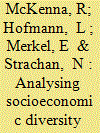|
|
|
Sort Order |
|
|
|
Items / Page
|
|
|
|
|
|
|
| Srl | Item |
| 1 |
ID:
150019


|
|
|
|
|
| Summary/Abstract |
Adequately accounting for interactions between Low Carbon Technologies (LCTs) at the building level and the overarching energy system means capturing the granularity associated with decentralised heat and power supply in residential buildings. The approach presented here adds novelty in terms of a realistic socioeconomic differentiation by employing dwelling/household archetypes (DHAs) and neighbourhood clusters at the Output Area (OA) level. These archetypes are combined with a mixed integer linear program (MILP) to generate optimum (minimum cost) technology configurations and operation schedules. Even in the baseline case, without any LCT penetration, a substantial deviation from the standard load profile (SLP) is encountered, suggesting that for some neighbourhoods this profile is not appropriate. With the application of LCTs, including heat pumps, micro-CHP and photovoltaic (PV), this effect is much stronger, including more negative residual load, more variability, and higher ramps with increased LCT penetration, and crucially different between neighbourhood clusters. The main policy implication of the study is the importance of understanding electrical load profiles at the neighbourhood level, because of the consequences they have for investment in the overarching energy system, including transmission and distribution infrastructure, and centralised generation plant. Further work should focus on attaining a superior socioeconomic differentiation between households.
|
|
|
|
|
|
|
|
|
|
|
|
|
|
|
|
| 2 |
ID:
169715


|
|
|
|
|
| Summary/Abstract |
We assess the ability of distributed solar to defer distribution capacity projects in a typical low load growth utility in the Northeast USA, PECO. We find that targeted placement can increase the deferral value of solar up to fourfold, but that deferrable projects are rare. In our baseline scenario, we find a 5% solar energy penetration with Net Energy Metering rolled out from 2020 to 2030 would increase rates by 0.8% over a 20-year horizon and generate just $1 MM in net present deferral value. This estimate assumes untargeted placement of solar, a low effective capacity (i.e. the reduction in peak load relative to solar's nominal capacity), a 1% growth rate, and 1% of PECO's distribution yearly capex budget that is deferrable. A higher effective capacity (e.g. from coupling energy storage with solar) and targeted placement could generate a net $8 MM of value over the same horizon, but the rate increase is mostly unaffected. We recommend the use of targeted solar placement in utility planning processes. Compared to untargeted placement, targeted placement can increase the total deferral value fourfold, but the effect on rates is small for PECO because few capacity deferral opportunities exist.
|
|
|
|
|
|
|
|
|
|
|
|
|
|
|
|
| 3 |
ID:
117226


|
|
|
|
|
| Publication |
2013.
|
| Summary/Abstract |
Electrification of transport fleets and heating sectors is seen as one of the key strategies to further reduce the use of fossil fuels and the resulting greenhouse gas emissions. However, it will potentially cause a significant increase of electricity peak demand and have adverse consequences on the electricity system, in particular on distribution networks. This paper will address the benefits of various applications of smart network control and demand response technologies for enhancing the integration of these future load categories, and for improvements in operation management and efficient use of distribution network assets. A range of numerical simulations have been carried out on different distribution network topologies (rural and urban networks) to identify the need and the cost of network reinforcement required to accommodate future load under various operating strategies such as Business as Usual (passive demand and passive network) against the smart grid approach. Applications of smart Plug-in vehicle (PiV) charging, smart heat pumps, and optimised control of network voltage regulators to reduce network investment have been studied, and selected key results of our studies on evaluating the benefits of implementing these technologies for Great Britain's distribution networks are presented and discussed in this paper.
|
|
|
|
|
|
|
|
|
|
|
|
|
|
|
|
|
|
|
|
|